The successes of laser and conventional LEDs manufacturers have opened up brilliant opportunities for projector manufacturers, allowing them to design models based on solid state light engines. In fact, laser is a LED with coherent radiation, which is much more powerful.
They practically do not heat up during operation, therefore they do not require the use of a powerful fan and a large internal volume to dissipate heat. This factor allowed the developers to radically reduce the size, creating a new segment of mini projectors on the market.
Of course, any projector is absolutely useless without content, and this factor significantly limited their popularity. But the development of screen mirroring technologies radically solved this problem, providing access to almost unlimited streaming content, for example, via a smartphone.
Projector phones vs smartphone + projector
Of course, the great promise of ‘pocket TV’ has not only been seen by projector manufacturers. Since 2009, smartphone developers have also started to develop this direction, periodically offering models with a built-in projector. Unfortunately, their brightness, including the most successful Samsung Galaxy Beam 1 and 2, did not exceed 15 / 20 ANSI lm, providing very dim and faded images even on a 50-inch screen in a dark room.
But the successful development of micro-electromechanical systems (MEMS) and solid state light engines gave a new impetus to this direction. As a result, in 2018 Samsung announced the Galaxy Beam 3 with brightness up to 50 ANSI lm. But this model did not hit the market. However, the list of smartphones with an integrated projector has expanded due to Blackview Max 1, Voga, Moviphone, etc, which actually became the 2nd generation projector phones.
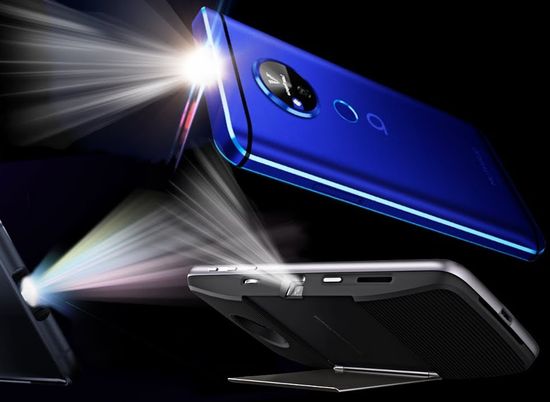
Their specs, including 50 ANSI lm brightness and WVGA (854 x 480) resolution, already provide acceptable image quality on the screen up to 50 inches in low ambient light.
But this direction again bogged down, losing the competition to the mini projector + smartphone combination. Indeed, a built-in projector increases the smartphone price by about $ 300-400. But projector developers have already offer a large number of excellent pocket-sized ultra-portable models for up to $ 200, the specs of which significantly exceeded those of built-in projectors.
In fact, modern projectors are conditionally divided into expensive powerful UST laser models with high image quality on 100-120″ screen, portable LED / laser universal projectors, and inexpensive pocket-sized ultra-portable projectors, mainly for use with a smartphone.
Living room projectors
Almost all modern projectors use the solid state light engines. They are divided into mid-focus portable models and premium Ultra Short Throw (UST) laser projectors, which are often used as an alternative with a huge screen instead of conventional TV. Sellers sometimes call them ‘living room projectors’. Chinese giant Hisense uses the name ‘laser TV’ for its gorgeous Hisense L5F and L9G projectors. But it seems a bit marketing, because they are really UST laser projectors with a built-in TV tuner and with a solid state light engine based on powerful lasers. Strictly speaking, any laser projector with an integrated TV tuner can be positioned as ‘laser TV’, the screen of which is placed outside the body.
As known, UST projectors are placed close to the screen, eliminating wiring problems.
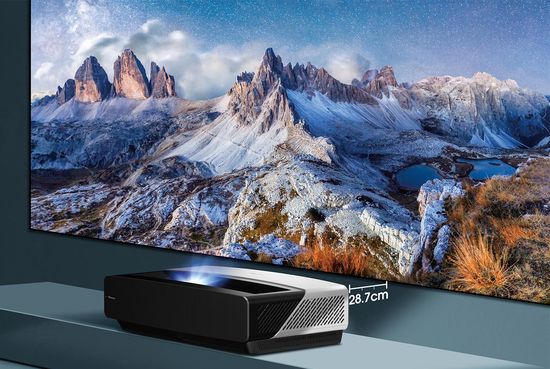
Today this area is developing rapidly. The range of premium UST models has expanded this year with:
– Epson EpiqVision series, including EH LS300 UST, EH LS500 4K UST and Mini EF12;
– VAVA 4K UST laser projector;
– Optoma CinemaX P2 4K laser projector;
– Hisense L5F and L9G UST laser TVs.
Portable projectors
For marketing reasons, companies are positioning most LED / laser models as mini portable projectors. But the use of ‘pocket’ in the name seems more reasonable, because its direct interpretation means the ability to carry the projector in a medium-sized pocket, which is important when using it with a smartphone. This list includes models weighing up to 5 lbs, but they are unlikely to fit even in a very large pocket.
The list of new portable models over $ 500 includes the XGIMI Halo+ and BenQ GV30.
1. XGIMI Halo Short Throw Projector – 600-800 ANSI lm brightness, 1920 x 1080 resolution, 1,000: 1 (full on / off) contrast, Throw Ratio 1.20: 1, Throw Distance 2.7 m at image size of 100″, size is 6.69 x 5.90 x 4.33 inches (17 x 15 x 11 cm), weight – 3.5 lbs (1.6 kg), features – Full HD 3D, Geometric Correction, HDR, Auto Focus, Android OS, Streaming Apps, Google Assistant, Harman Kardon Speakers, WiFi Bluetooth, Memory Card Reader – $ 800.
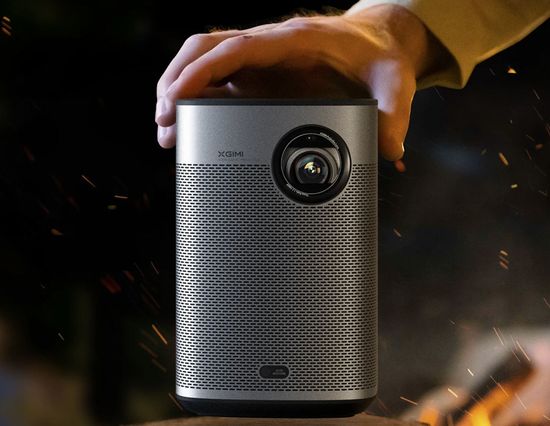
This premium projector can be used as a TV alternative, for example, for a bedroom, or for an outdoor movie night on a camping trip. Many experts call it this year’s best projector.
2. BenQ GV30 Projector – 300 ANSI lm brightness, 1280 x 720 resolution, 100,000: 1 dynamic contrast, Throw Ratio 1.20: 1, Throw Distance 2.7 m for image size of 100″, size is 7.87 x 4.72 x 7.48 inches (20 x 12 x 19 cm), weight – 3.5 lbs (1.6 kg), features – auto focus, Android OS, Streaming Apps, Google Assistant – $ 600.
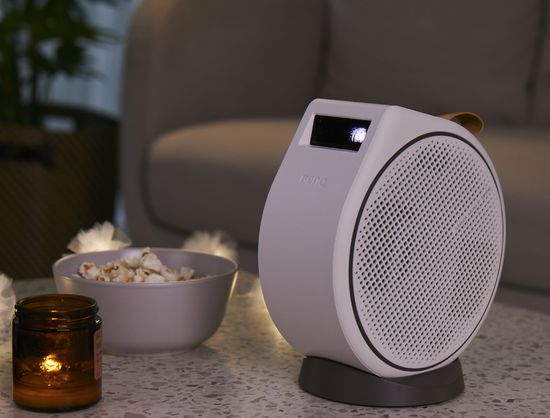
Its shape, weight and dimensions are not very convenient for a pocket, but its stylish design fits harmoniously into any interior.
Mid budget portable projectors
1. Miroir M600 Projector – 600 ANSI lm brightness, 1920 x 1080 resolution, 300: 1 (full on / off) contrast, Throw Ratio 1.20: 1, Throw Distance 2.7 m at image size of 100″, size is 1.18 x 9 x 4.72 inches (3 x 23 x 12 cm), weight – 1.8 lbs (0.8 kg), features – Vertical Digital Keystone, Audio Out Mini Jack, HDMI, USB x 2 – $ 500.
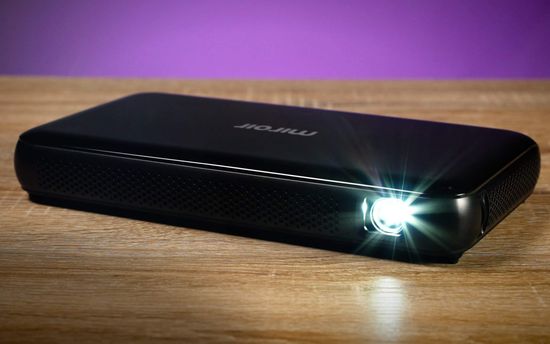
The parallelogram design is ideal for carrying in a pocket, but the 9-inch width and 1.8 lb weight is a little too big for a pocket model.
2. AAXA M7 Projector – 650 LED lm and 1,200 LED lm brightness in Boost mode, 1920 x 1080 resolution, 2,000: 1 (full on / off) contrast, Throw Ratio 1.20: 1, size is 1.96 x 7.48 x 6,3 inches (5 x 19 x 16 cm), weight – 3.0 lbs (1.4 kg), features – Vertical Digital Keystone, Memory Card Reader, Audio Out Mini Jack, HDMI, USB – $ 490.
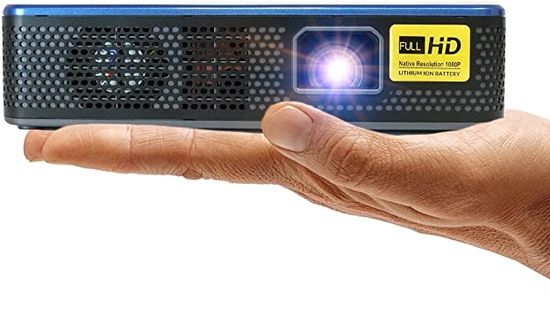
This model works on battery for up to 3 hours, supports connection to a smartphone or tablet for screen mirroring, and provides access to files on a MicroSD card or USB memory stick. The limited list of supported video file formats and the lack of WiFi are its minor cons.
Brightness, battery life, form factor, size and weight make the AAXA M7 the most versatile projector up to $ 500 that can be used in the bedroom instead of a TV, or as a a portable addition to your smartphone on a camping trip.
LED lm vs ANSI lm
AAXA M7 specs indicate 1,200 LED lm brightness in Boost mode and 650 LED Lm in other modes. Moreover, 650 LED Lm brightness corresponds to approximately 850-1,500 ANSI lm (the coefficient varies in the range 1.3 – 2.4). Of course, this brightness is unprecedented for portable models.
The use of ‘LED lm’ to measure brightness requires a little explanation. As known, the projector brightness directly affects the saturation of colors under ambient light, and, accordingly, image quality. Therefore, low-brightness projectors produce dim and faded images even in low ambient light. Of course, companies prefer to use measurement techniques that take into account the pros of the projection technologies used. As a result, the brightness of modern projectors under different brands is measured by different methods and reported in different units. For example, Epson uses Color Light Output (CLO) because their projectors’ 3LCD technology produces images with no loss in brightness. Accordingly, they have an equally high White and Color Light Output (CLO). According to the company, the brightness of 3LCD technology is about 3 times that of DLP technology.

Today the list of used units for projector brightness includes ANSI lm, LED Lm (Helmholtz–Kohlrausch effect), CLO (Epson 3LCD projectors), and even Lux (screen lighting). Of course, their comparison is incorrect without taking into account the corresponding coefficients. For example, 1 ANSI lm provides 1 Lux on a 1m² screen. Accordingly, 1 ANSI lm = 1 Lux for 57 inches diagonal, and 3.2 Lux for 100 inches diagonal.
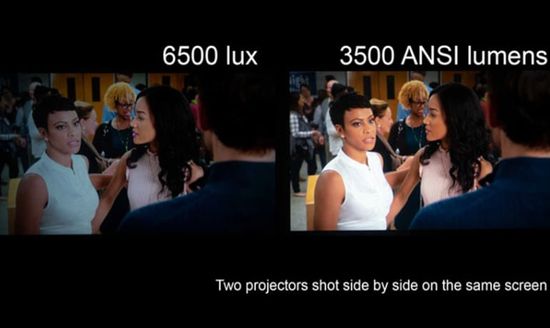
New cubic pocket projectors
1. AAXA HP2 Halloween Special FX Pico Projector – 100 LED Lm brightness (130 – 240 ANSI lm), 640 x 360 resolution, 2,000: 1 (full on / off) contrast, Throw Ratio 1.65: 1, size is 2.75 x 2.36 x 2.75 inches (7 x 6 x 6 cm), weight – 0.3 lbs (0.1 kg), features – Direct Screen Mirroring connection through its USB-C (compatible) port, Memory Card Reader, tripod- $ 130.
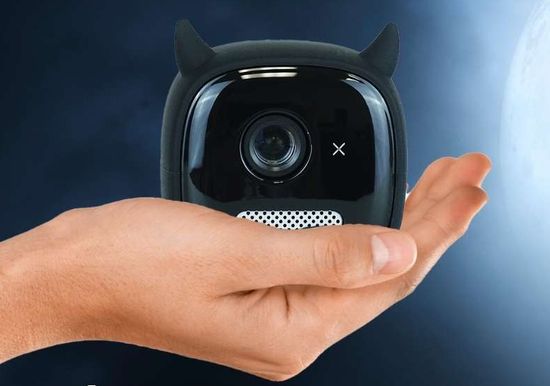
Probably today it’s the cheapest, smallest and lightest projector. Unfortunately, its form factor is not very pocket-friendly, and the design will seem a little childish to many. But there is no doubt that this projector will be the perfect gift for any child.
2.Vankyo GO200 Projector – 200 ANSI Lm brightness, 854 x 480 resolution, 70,000: 1 dynamic contrast ratio, throw-distance range from 4.9 to 16.4 feet, size 2.4 x 2.4 x 2.4 inches (6 x 6 x 6 cm), weight – 0.44 lbs (0.2 kg), features – Auto Keystone Correction ± 40 °, Android OS, Streaming Apps, Audio Out Mini Jack, HDMI, Wireless Networking – $ 260.
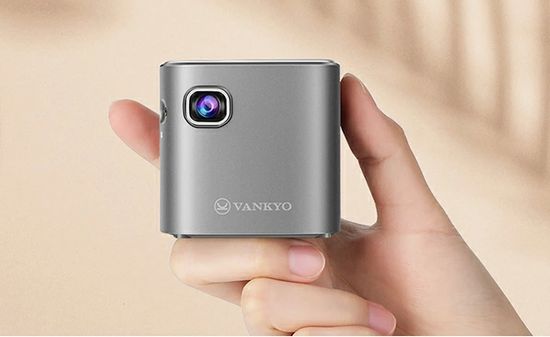
This model is twice as expensive, but its specs and functionality make up for the difference in price. Today Vankyo GO200 is one of the lightest and most compact models with mid-budget specs.
Parallelepiped form factor pocket projectors
1. Miroir M190 Projector – 200 ANSI Lm brightness, 854 x 480 resolution, 300: 1 (full on / off) contrast, Throw Ratio 1.20: 1, size is 0.78 x 5.9 x 3.54 inches (2 x 15 x 9 cm), weight – 1.00 lbs (0.5 kg), features – Vertical Digital Keystone, Audio Out Mini Jack, HDMI, USB x 2 – $ 230.

Its form factor and size are ideal for carrying in your pocket, making this model the best choice as a pocket projector for your smartphone.
2. Pico Genie Impact 4.0 Projector – 500 ANSI Lm brightness, 960 x 540 resolution, 3,000: 1 (full on / off) contrast, Throw Ratio 1.20: 1, size is 1.96 x 3.54 x 6.3 inches (5 x 9 x 16 cm), weight – 1.32 lbs (0.6 kg), features – Memory Card Reader, Geometric Correction, Auto Focus, Android OS – $ 425.
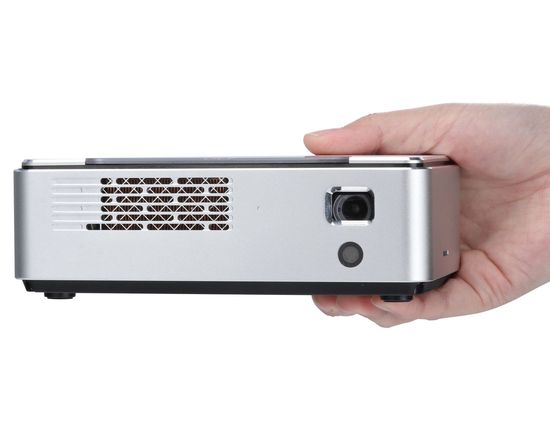
Specs of this model correspond to a fairly high level. Of course, its height (1.96 in or 5 cm) is too big for a pocket, but the high image quality compensates for this aspect. Perhaps it can be positioned as a budget version of the AAXA M7 for $ 490. Today, these models are ideal as a versatile projector that is equally convenient for use at home or on a camping trip.
Conclusion
Modern projectors are conventionally divided into several types.
1.Expensive powerful UST laser living room projectors as an alternative to TV.
The list of 2021 most popular models includes:
– VAVA 4K UST laser projector;
– Optoma CinemaX P2 4K laser projector;
– Hisense L5F and L9G UST laser TVs.
2. Mid-focus universal portable projectors with high enough specs.
This list includes the XGIMI Halo (2021), BenQ GV30, Miroir M600 and AAXA M7.
3. Relatively cheap, very light and compact pocket-sized ultra-portable projectors, which are very convenient for sharing with a smartphone outside the home. This year, the list of the most popular models has expanded with the AAXA HP2, Vankyo GO200, Miroir M190 and Pico Genie Impact 4.0.
The form factor and specs make the AAXA M7 and Pico Genie Impact 4.0 the best all-around models. Miroir M190 is ideal as a pocket model for smartphones.
Until recently, the value for money smartphone + pocket projector confidently outperformed projector phones. But 2021 added intrigue to this confrontation. The HMD Global Company and South Korean giant Samsung have announced the new Samsung Galaxy Beam 3 (2021) and Nokia Projector Phone 5G projector phones. The premium Samsung Galaxy Beam 3 will cost $ 1,700 / £ 1,300 and is will hardly compete with the budget ‘smartphone + pocket projector’ solution. But Nokia’s announced price of about $ 500 is in line with this price segment. Even a partial implementation of the stated specs (120-inch projection size, 1920 x 1080p resolution, 3000 Lm brightness) will be a serious challenge for modern pocket projectors.
This video showcases a new premium XGIMI Halo+ portable projector.
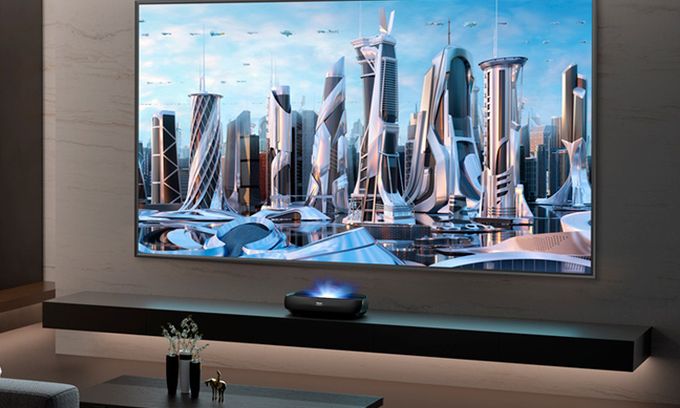
Pingback: New projector smartphones. Review - The Appliances Reviews
Pingback: Smartphones with Built-in Projector or Projector Phone Review - The Appliances Reviews